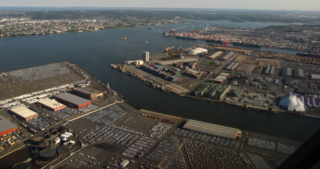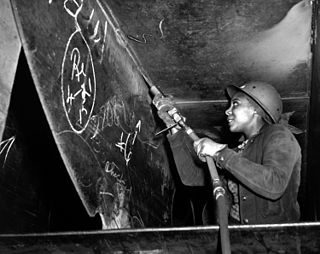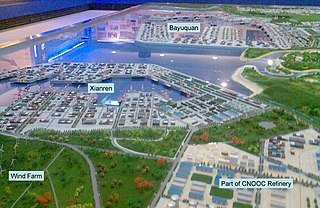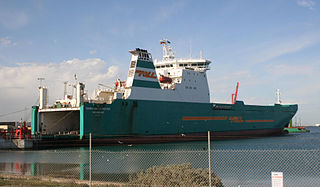
Richmond is a city in western Contra Costa County, California, United States. The city was incorporated on August 7, 1905, and has a city council. Located in the San Francisco Bay Area's East Bay region, Richmond borders San Pablo, Albany, El Cerrito and Pinole in addition to the unincorporated communities of North Richmond, Hasford Heights, Kensington, El Sobrante, Bayview-Montalvin Manor, Tara Hills, and East Richmond Heights, and for a short distance San Francisco on Red Rock Island in the San Francisco Bay.

Port Newark–Elizabeth Marine Terminal, a major component of the Port of New York and New Jersey, is the principal container ship facility for goods entering and leaving the New York metropolitan area and the northeastern quadrant of North America. Located on Newark Bay, the facility is run by the Port Authority of New York and New Jersey. Its two components, Port Newark and the Elizabeth Marine Terminal sit side by side within the cities of Newark and Elizabeth, New Jersey, just east of the New Jersey Turnpike and Newark Liberty International Airport.

Rosie the Riveter World War II Home Front National Historical Park is a United States national historical park located in Richmond, California, near San Francisco. The park preserves and interprets the legacy of the United States home front during World War II, including the Kaiser Richmond Shipyards, the Victory ship SS Red Oak Victory, a tank factory, housing developments and other facilities built to support America's entry into World War II. In particular, the role of women and African-Americans in war industries is explored and honored.

The Port of Long Beach, administered as the Harbor Department of the City of Long Beach, is a container port in the United States, which adjoins Port of Los Angeles. Acting as a major gateway for US–Asian trade, the port occupies 3,200 acres (13 km2) of land with 25 miles (40 km) of waterfront in the city of Long Beach, California. The Port of Long Beach is located less than two miles (3 km) southwest of Downtown Long Beach and approximately 25 miles (40 km) south of Downtown Los Angeles. The seaport generates approximately US$100 billion per year in trade and employs more than 316,000 people in Southern California. In 2022, the port, together with the adjoining Port of Los Angeles, were considered amongst the world's least efficient ports by the World Bank and IHS Markit citing union protectionism and a lack of automation.

The Port of Halifax comprises various port facilities in Halifax Harbour in Halifax, Nova Scotia, Canada. It covers 10 km2 (3.9 sq mi) of land, and looks after 150 km2 (58 sq mi) of water.

The Port of Mobile is a deep-water port in Mobile, Alabama, United States. It is the only deep-water port in Alabama. It was ranked by the United States Army Corps of Engineers as the 9th largest port by tonnage in the nation during 2014, with a trade volume of 64.3 million tons. This ranking had increased from 12th largest during 2010, with a trade volume of 55,713,273 tons, an increase of 19.1%.

Teesport is a large sea port located in the unitary authority of Redcar and Cleveland, in the ceremonial county of North Yorkshire, Northern England.

Marina Bay, is located in Richmond's protected Richmond Inner Harbor. It was developed in the mid-1980s in an effort to clean up what had been up to that point the defunct World War II-era Kaiser Shipyards.
Essar Shipping Ltd., now Essar Shipping Ports & Logistics Limited, is an Indian shipping corporation for the global energy business. Founded in 1945, the company was incorporated in 2010. The company was listed in Bombay Stock Exchange. The company headquarters is located in Mumbai. The company is a part of Essar Group.

Ports of Auckland Limited (POAL), the successor to the Auckland Harbour Board, is the Auckland Council-owned company administering Auckland's commercial freight and cruise ship harbour facilities. As the company operates all of the associated facilities in the Greater Auckland area, this article is about both the current company and the ports of Auckland themselves.

The Port of San Diego is a seaport in San Diego, California. It is located on San Diego Bay in southwestern San Diego County, California, and is a self-supporting district established in 1962 by an act of the California State Legislature. In addition to port activities, the Port District controls San Diego Bay and owns and manages the Bay's immediate waterfront under the state's Tidelands Trust.

The Port of Málaga is an international seaport located in the city of Málaga in southern Spain, on the Costa del Sol coast of the Mediterranean. It is the oldest continuously-operated port in Spain and one of the oldest in the Mediterranean.

The Port of Tacoma is an independent seaport located in Tacoma, Washington. The port was created by a vote of Pierce County citizens on November 5, 1918. The Edmore was the first ship to call at the port in 1921. The port's marine cargo operations, among the largest in the United States, was merged with the Port of Seattle's in 2015 to form the Northwest Seaport Alliance.

The Port of Yingkou is an international seaport in Yingkou, Liaoning, People's Republic of China. It is the second-largest port in northeast China and the tenth-largest nationwide. It includes two separate dockland areas, the Yingkou old port at the mouth of the Daliao River, and the Bayuquan port located directly on Liaodong Bay on the Bohai Sea.

The Port of Southampton is a passenger and cargo port in the central part of the south coast of England. The modern era in the history of the Port of Southampton began when the first dock was inaugurated in 1843. After the Port of Felixstowe, Southampton is the second largest container terminal in UK, with a handled traffic of 1.5 million twenty-foot equivalent units (TEU). It also handles cruise ships, roll-on roll-off, dry bulk, and liquid bulk.

Port Botany is a deepwater seaport located in Botany Bay in Sydney, Australia. The port is dominated by trade in containerised manufactured products and, to a lesser extent, bulk liquid imports including petroleum and natural gas. It is one of Australia's largest container ports and is administered by NSW Ports which entered into a 99-year lease agreement with the Port Authority of New South Wales in May 2013.

The Chevron Richmond Refinery is a 2,900-acre (1,200 ha) petroleum refinery in Richmond, California, on San Francisco Bay. It is owned and operated by Chevron Corporation and employs more than 1,200 workers, making it the city's largest employer. The refinery processes approximately 240,000 barrels (38,000 m3) of crude oil a day in the manufacture of petroleum products and other chemicals. The refinery's primary products are motor gasoline, jet fuel, diesel fuel and lubricants.

Mundra Port is India's first private port, largest container port and largest commercial port, located on the northern shores of the Gulf of Kutch near Mundra, Kutch district, Gujarat. Formerly operated by Mundra Port and Special Economic Zone Limited (MPSEZ) owned by Adani Group, it was later expanded into Adani Ports & SEZ Limited (APSEZ) managing several ports. In FY 2020–21, Mundra Port handled 144.4 million tonnes of cargo. The port currently handles over 155 MT, which constitutes nearly 11 per cent of India’s maritime cargo. The port also handles nearly 33 per cent of India’s container traffic.
The Port of Paulsboro is located on the Delaware River and Mantua Creek in and around Paulsboro, in Gloucester County, New Jersey, approximately 78 miles (126 km) from the Atlantic Ocean. Traditionally one of the nation's busiest for marine transfer operations, notably for crude oil and petroleum products, such as jet fuel and asphalt, it is a port of entry with several facilities within a foreign trade zone.

Webb Dock is a port facility at Fishermans Bend in Melbourne, Victoria constructed progressively from 1960, by dredging and land fill at the mouth of the Yarra River. It includes roll-on/roll-off facilities handling motor vehicle import and export and break bulk commodities and a container terminal. The dock is named after John Percival Webb OBE, a former Melbourne Harbor Trust commissioner.






















